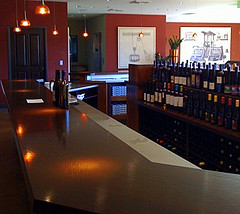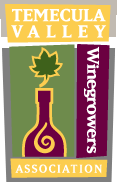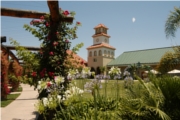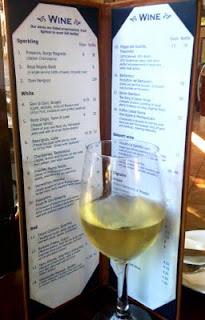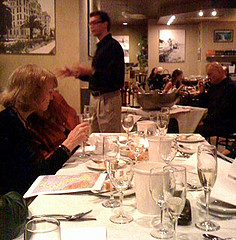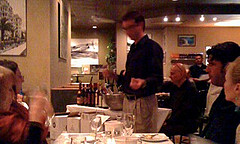The holidays always call for special wines. You can bring out all the heavy-hitting Cabernets, big Bordeaux blends and dry-as-a-bone Rieslings you want. The wines that create the biggest stir and the ones that make the biggest impression on your guests are dessert wines. Sweet and delectable, dessert wines fit in with the holiday mood almost as well as cranberry sauce and pumpkin pie. As a matter of fact, they fit right in with the cranberry sauce and pumpkin pie. The Monterey County Vintners & Growers Association supplied me with a small treasure chest of these sweet delights and asked me to pass along my impressions. The following wines were provided to me at no cost for the purpose of review. All of them are in 375ml bottles - except the Potbelly Port, which is in a 500ml bottle - and the prices were provided by the MCVGA.
J Lohr Vineyards Late-Harvest White Riesling ($25) - The 2006 vintage was the first White Riesling crop since 1995 for J Lohr's Bay Mist vineyard in the Arroyo Seco region of Monterey County. It's a 100% varietal wine with 12.3% abv and a luscious 10.3% residual sugar. Don't write this one off by sniffing "sweetie" and moving along. The sugar belies a wonderful acidity that makes this wine great for pairing with desserts. You may like it with an apple tart and vanilla bean ice cream. You may also like it all by itself. There's a nose of honeyed fruit and, on the palate, that wonderful "bitter with the sweet" sensation one hopes for in a Riesling. A beautiful, rich golden color looks great in the glass, too.
Joyce Vineyards Pudding Wine 2007 ($28) - The Johannesburg Riesling grapes for this wine came from the Franscioni Vineyard. Luscious to look at - it's a deep, rich golden color - the aromas and the flavor remind me of a very fine sherry. It should go very nicely with a pumpkin or pecan pie. If your sweet tooth isn't shouting for attention, you may find that it makes a fine dessert on its own. 12.5% abv may be a tad high for some, in a dessert wine, but you could minimize the effect of the alcohol by doing as the Monterey wine people recommend - have a pear poached in Pudding Wine.
Paraiso, Souzao Port, Santa Lucia Highlands, Monterey County NV ($25) - Listed as a "tasting room only" wine on their website, this 18.5% abv port-style wine is made from the Souzao grape, which is a Portuguese varietal but now becoming more common in California. The Paraiso Estate features only about three acres of Souzao, but they managed nearly 600 cases of production. The wine is aged in French and American oak for two years before bottling. Quite viscous and very full in the mouth, it's got a rich nose full of candy cherry aromas and an explosive taste that reminds me of raisins and chocolate-covered cherries at the same time. It's a bit rough and over-the-top, so don't expect too much subtlety. Serve this with chocolate and score big with sweet-toothed guests.
Graff Family Vineyards, Chalone, July Muscat 2007 ($16) - Billed as a sweet table wine, this is made from grapes grown in the Chalone appellation. It's 100% July Muscat, quite a rare grape variety developed in the '50s at UC Davis. Its 10% residual sugar and 11.3% abv level gives a soft and aromatic wine with strong floral notes. It's an amazing accompaniment to an apricot or pear tart.
Ventana Vineyards Orange Muscat 2008 ($18) - Tropical fruit and vanilla greet the nose, while the flavors of peaches dominate on the palate. The alcohol level is 15% - quite a bit higher than most Muscats - and residual sugar is 7.2%. You can serve this chilled as an apertif, or alongside a biscotti.
Mer Soleil LATE Late-Harvest Viognier 2004 ($36) - Botrytis-influenced Viognier gives a warm, golden color in the glass and the aromas are as sweet as honey. The taste is sweet, too, but with a good level of acidity that sports a nice hint of orange peel. Expect a lush and long finish. Pair this with Foie Gras or with warm blue cheese-stuffed Mission Figs for a delightful dessert.
Pessagno Late-Harvest Sauvignon Blanc 2006 ($25) - Fully Botrytised grapes from the Arroyo Seco appellation clock in at 13.8% abv and 18.4% residual sugar and spent five months in wood, making this a dessert wine lover's dessert wine. This Sauterne-style wine is dessert all by itself, but you can drizzle it over fruit or let it make a Creme Brulee memorable.
Kendall-Jackson Late-Harvest Chardonnay 2006 ($25) - Floral and cinnamon aromas lead to candied fruit flavors in this lush drink. The winemaker calls it "the nectar of the gods." He may be biased, but he does know what he's talking about. This sweet Chard really dresses up a plate of butter cookies.
Mission Trail, Potbelly Port ($36) - Maybe the unflattering name arises from the fact that this wine is jammed full of grapes. There are six Portuguese grapes here - Touriga Nacional, Tinto Cao, Tinta Roriz, Souzao, Tinta Madeira and Tempranillo. Brandy was added halfway through the fermentation. The result is a Port that is jammy and rich, with flavors of chocolate-covered cherries, black pepper, anise, tobacco and clove. Top off your feast with this portly port and a chocolate bread pudding for a dessert as memorable as the holiday.








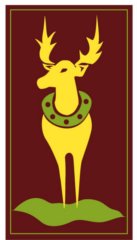

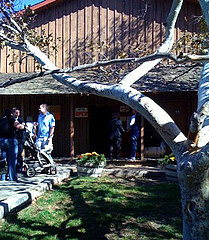





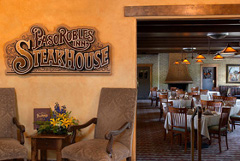

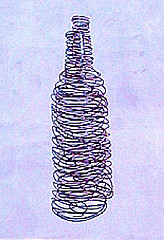 There's an interesting piece of art on the face of it, an almost-abstract wire representation of a wine bottle. Inside is a small lower lobby with stairs and elevator. Once on the second floor, I completely forgot I was a stone's throw from Andersen's Pea Soup.
There's an interesting piece of art on the face of it, an almost-abstract wire representation of a wine bottle. Inside is a small lower lobby with stairs and elevator. Once on the second floor, I completely forgot I was a stone's throw from Andersen's Pea Soup.